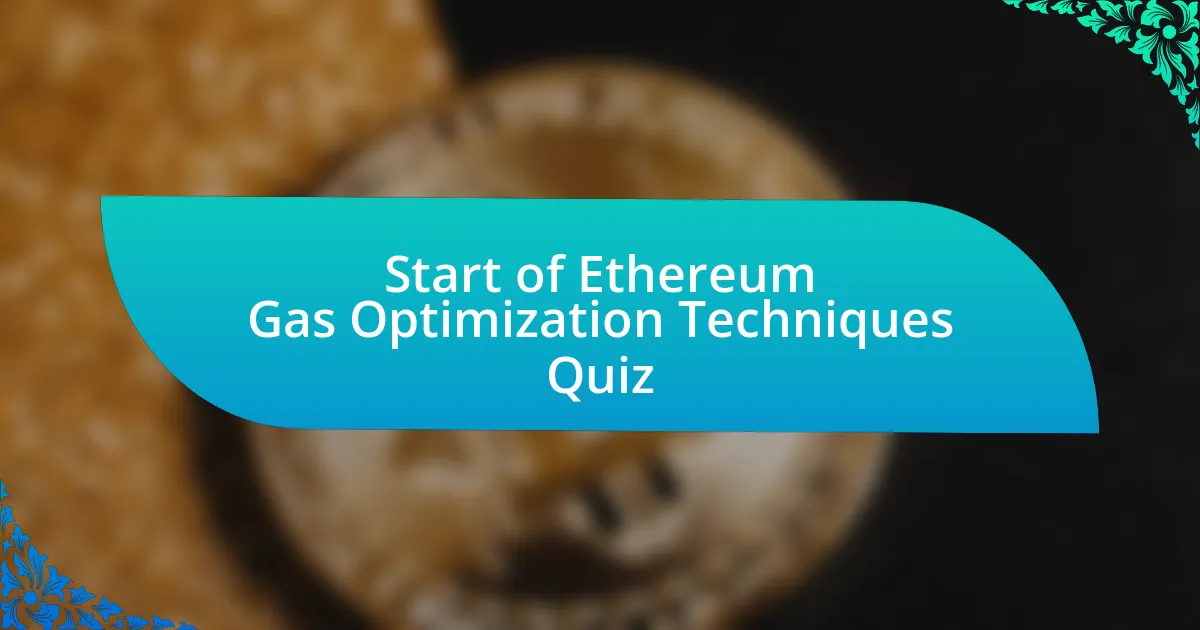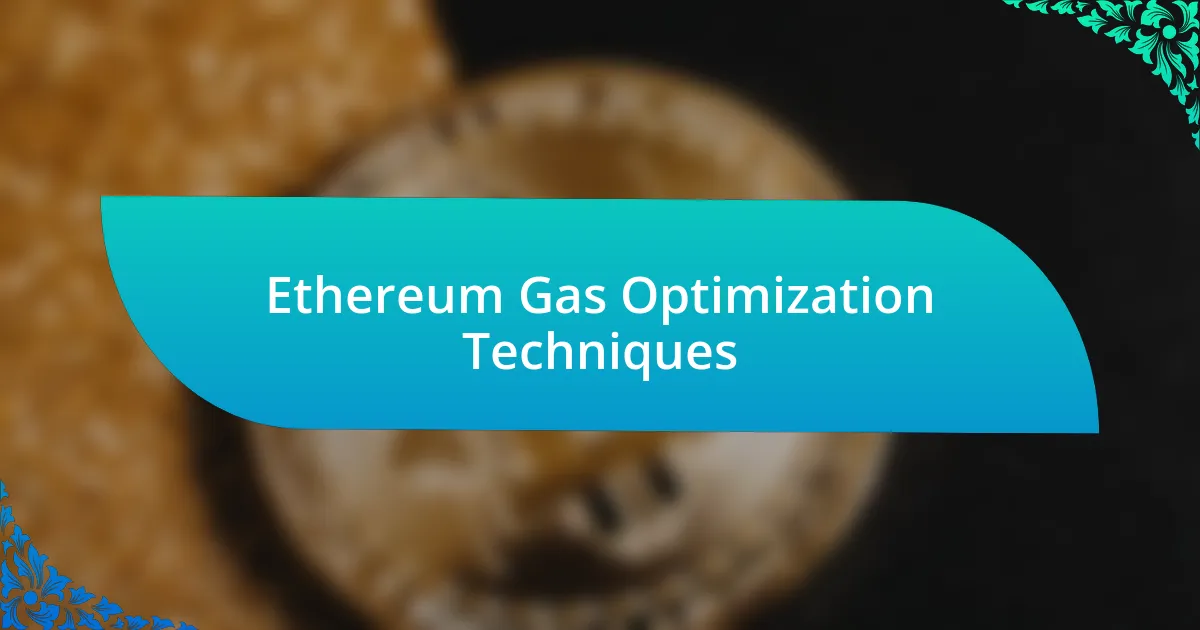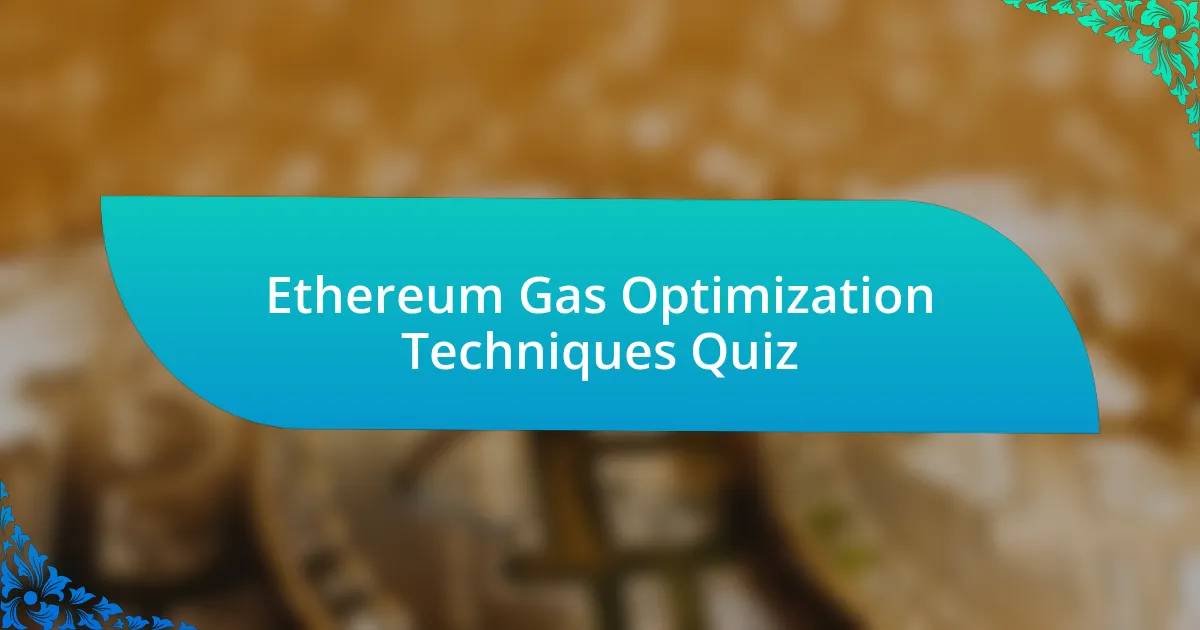
Start of Ethereum Gas Optimization Techniques Quiz
1. What is the primary goal of gas optimization in Ethereum smart contracts?
- The primary goal is to ensure that all transactions are executed without any fees.
- The primary goal is to maximize the amount of data stored on the blockchain.
- The primary goal is to minimize gas costs to reduce transaction fees and enhance efficiency.
- The primary goal is to increase the transaction speed of smart contracts.
2. How can reducing on-chain data help in gas optimization?
- Reducing on-chain data exclusively increases the number of transactions on the network.
- Reducing on-chain data leads to longer processing times for transactions.
- Reducing on-chain data minimizes the consumption of gas by reducing storage needs.
- Reducing on-chain data makes smart contracts less secure and more vulnerable.
3. What is a simple trick to reduce gas costs by minimizing on-chain data?
- Using events to store data off-chain instead of storing it directly on-chain.
- Writing all data directly to the blockchain for permanent storage.
- Ignoring data size and focusing only on transaction frequency.
- Compressing all data into a single transaction to optimize costs.
4. What are the benefits of using mappings over arrays in Solidity?
- Using mappings makes it easier to sort data than arrays.
- Using mappings saves gas by avoiding the need to loop through all elements in an array.
- Using mappings simplifies data management compared to arrays.
- Using mappings allows for direct access to elements without searching.
5. How much gas can be saved by substituting an array with a mapping?
- Approximately 25% of gas can be saved by using a mapping instead of an array.
- Up to 50% of gas can be saved by using a mapping instead of an array.
- Around 75% of gas can be saved by using a mapping instead of an array.
- On average, 89% of gas can be saved by using a mapping instead of an array.
6. What is the impact of using constants and immutable variables on gas costs?
- These variables do not consume storage space in the Ethereum Virtual Machine (EVM), reducing gas costs associated with storage operations.
- These variables incur a constant fee every time they are accessed, raising overall costs.
- These variables do not affect the performance of gas consumption in transactions.
- These variables require more memory, increasing gas costs significantly.
7. How can using constants and immutable variables help in gas optimization?
- They can be changed at runtime, which optimizes gas usage.
- Their flexibility increases the gas consumption when deployed.
- They require more storage space, which reduces gas efficiency.
- Their values are compiled directly into the smart contract bytecode, reducing gas costs.
8. What is the effect of using dynamic arrays compared to fixed-length arrays on gas costs?
- Dynamic arrays are cheaper because they require less storage space than fixed-length arrays.
- Dynamic arrays are more expensive because the EVM needs to keep track of and update their length every time a new item is added.
- Fixed-length arrays are more expensive because they require multiple state updates when modified.
- Dynamic arrays have no effect on gas costs as both are equally priced in contract executions.
9. How can modifying function visibility modifiers help in gas optimization?
- Changing visibility to private allows better handling of state changes and reduces gas expenses.
- Increasing the number of internal functions can reduce gas costs by optimizing code execution.
- Making functions external can make them more gas-efficient when dealing with large arrays by accepting arrays from calldata.
- Setting all functions as public improves visibility, leading to lower gas usage across the network.
10. What is the role of the Solidity compiler in optimizing gas usage?
- The compiler translates code into different programming languages for interoperability.
- The compiler is responsible for managing user permissions in smart contracts.
- The compiler only checks syntax errors in the code before deployment.
- The compiler optimizes code to minimize gas consumption during contract executions.
11. How can writing code in assembly help in gas optimization?
- Writing code in assembly results in consistently higher gas costs due to the complexity of the language.
- Writing code in assembly allows for manual optimization of opcodes, potentially outperforming Solidity bytecode in certain scenarios.
- Writing code in high-level languages always guarantees better performance due to abstraction.
- Using assembly makes the code less readable, leading to more errors and inefficiencies in gas usage.
12. What are some expensive gas operation codes in EVM?
- CALL/CALLCODE (15,000 gas)
- LOG/LOG0 (10,000 gas)
- ADD/SUB (5,000 gas)
- CREATE/CREATE2 (32,000 gas), SSTORE (20,000 gas if the slot has not been accessed, 2,900 otherwise)
13. How can pre-calculating static values help in gas optimization?
- Pre-calculating static values requires more storage for variables, increasing gas costs.
- Pre-calculating static values eliminates the need for any contract interactions.
- Pre-calculating static values increases gas usage by creating confusion.
- Pre-calculating static values can reduce gas consumption by avoiding unnecessary function calls.
14. What is the impact of declaring temporary variables on gas costs?
- Declaring temporary variables saves gas because they are cleared automatically.
- Declaring temporary variables requires more gas because they are stored in memory rather than on the blockchain.
- Declaring temporary variables has no effect on gas costs at all.
- Declaring temporary variables reduces gas costs by using less storage.
15. How can avoiding multiple changes to state variables help in gas optimization?
- Changing state variables only once is sufficient to optimize gas usage even if multiple changes are made.
- Avoiding multiple changes to state variables reduces the number of SSTORE operations, thereby minimizing gas consumption.
- Making frequent updates to state variables increases the number of SSTORE operations, raising gas costs.
- Updating state variables in batches does not affect gas costs compared to updating them individually.
16. What is the benefit of removing unnecessary variables in Ethereum smart contracts?
- Removing unnecessary variables has no impact on gas refunds or transaction value.
- Removing unnecessary variables can return gas refunds, up to half of the transaction value, using the delete keyword.
- Removing unnecessary variables increases the overall contract size, leading to higher deployment costs.
- Removing unnecessary variables generally makes the code more complex and less readable.
17. How can using selfdestruct() help in gas optimization?
- Using selfdestruct() optimizes transactions by increasing contract size.
- Using selfdestruct() can return gas by deleting a contract.
- Using selfdestruct() adds gas costs for contract creation.
- Using selfdestruct() keeps contracts active without changes.
18. What is the purpose of the Solidity Gas Optimizer?
- The Solidity Gas Optimizer enhances the aesthetics of the code written in Solidity.
- The Solidity Gas Optimizer increases the number of functions in a smart contract.
- The Solidity Gas Optimizer helps in identifying and optimizing gas-consuming operations in smart contracts.
- The Solidity Gas Optimizer focuses on improving the user interface of Ethereum applications.
19. How can minimizing function calls to third-party smart contracts help in gas optimization?
- Minimizing function calls reduces the overall gas consumption by minimizing the number of external function calls.
- Calling multiple contracts within a single transaction saves gas costs effectively.
- Reducing the complexity of function calls increases gas consumption significantly.
- Increasing the number of function calls allows for more complexities in transactions.
20. What is the impact of using the –optimize flag in the Solidity compiler on gas costs?
- The –optimize flag performs several hundred runs, streamlining the bytecode and reducing gas consumption during contract executions.
- The –optimize flag has no effect on gas costs or execution efficiency in the Solidity compiler.
- The –optimize flag reduces the number of smart contracts allowed in a single transaction, increasing gas costs.
- The –optimize flag increases the execution time and gas costs by adding more logic to the bytecode.
21. How can specifying the –runs command help in optimizing gas costs?
- Specifying the –runs command will always optimize every transaction regardless of contract complexity.
- Specifying the –runs command increases the size of the contract, leading to higher gas costs.
- Specifying the –runs command lets you define the number of runs for optimization, which can be adjusted based on the application`s unique needs.
- Specifying the –runs command can reduce the number of compiled functions, minimizing contract efficiency.
22. What is the role of assembly in optimizing gas usage in Ethereum smart contracts?
- Assembly eliminates the need for gas fees entirely in Ethereum transactions.
- Assembly increases the complexity of code, making it less efficient overall.
- Assembly simplifies code by automatically optimizing all operations.
- Assembly allows for manual optimization of opcodes, potentially outperforming Solidity bytecode in certain scenarios.
23. How can avoiding unnecessary and unused code help in gas optimization?
- Removing code can increase gas costs due to additional processing.
- Keeping all code can improve performance by providing flexibility.
- Unused code does not affect the contract`s execution time or cost.
- Avoiding unnecessary and unused code minimizes the size of the smart contract and reduces the cost of executing the constructor.
24. What are some common gas-consuming operations in EVM?
- HASH, UPDATE, and other operations like QUERY and GET.
- PRINT, INSERT, and other operations like DELETE and FIND.
- DISPLAY, WRITE, and other operations like READ and TRAVERSE.
- CREATE/CREATE2, SSTORE, and other operations like CALL and CALLCODE.
25. How can using fixed-length arrays instead of dynamic arrays help in gas optimization?
- Using fixed-length arrays leads to higher gas costs because of unnecessary checks.
- Using dynamic arrays maximizes gas costs due to fixed sizes.
- Using arrays of variable length increases efficiency by minimizing gas expenses.
- Using fixed-length arrays reduces gas costs because the EVM does not need to keep track of and update the array length.
26. What is the impact of specifying the required type in arrays on gas costs?
- Specifying types leads to more storage space being used, increasing gas costs.
- Specifying the required type in arrays helps the engine pack the data correctly, reducing gas costs.
- Specifying types in arrays increases complexity, leading to higher gas costs.
- Specifying the type in arrays has no effect on gas costs.
27. What is the benefit of using the delete keyword in Ethereum smart contracts?
- Using the delete keyword creates a permanent log of state changes.
- Using the delete keyword increases contract complexity and gas consumption.
- Using the delete keyword returns gas refunds, up to half of the transaction value, by deleting variables.
- Using the delete keyword automatically upgrades the contract to a newer version.
28. How can reducing on-chain data help in gas optimization within smart contracts?
- Excess on-chain data speeds up contract execution and lowers gas costs.
- Reducing on-chain data has no effect on gas costs within blockchain transactions.
- Increasing on-chain data lowers transaction fees by providing more details.
- Reducing on-chain data minimizes the consumption of gas by reducing storage needs.
29. What is a simple trick for minimizing gas costs related to on-chain data storage in Ethereum?
- Increasing transaction fees to manage data better.
- Utilizing fixed-length arrays for all data storage needs.
- Using events to store data off-chain instead of storing it directly on-chain.
- Storing all data in dynamic arrays to retain flexibility.
30. What is a method to optimize gas usage related to the storage of data in Ethereum smart contracts?
- Using events to store data off-chain instead of storing it directly on-chain.
- Employing dynamic arrays for storing temporary data.
- Utilizing fixed-length arrays exclusively for every variable.
- Increasing the number of state variables for clarity.

Congratulations! You’ve Successfully Completed the Quiz
Thank you for participating in our quiz on Ethereum Gas Optimization Techniques. We hope you found the process enjoyable and enlightening. By exploring this topic, you’ve likely gained insights into crucial aspects of blockchain efficiency, such as gas fees and smart contract optimization. Understanding these concepts is essential for anyone looking to navigate the Ethereum ecosystem effectively.
Throughout the quiz, you may have discovered practical strategies to reduce transaction costs and improve the performance of decentralized applications. The importance of optimizing gas usage cannot be overstated; it can lead to significant savings and a better user experience. The knowledge gained here empowers you to make informed decisions in your blockchain endeavors.
To further enhance your understanding, we invite you to check out the next section on this page. It is dedicated to expanding your knowledge of Ethereum Gas Optimization Techniques. Dive deeper into this critical subject and explore advanced strategies that can take your skills to the next level. Happy learning!

Ethereum Gas Optimization Techniques
Introduction to Ethereum Gas and Its Importance
Ethereum gas refers to the unit that measures the amount of computational effort required to execute operations, including transactions, on the Ethereum blockchain. Gas is crucial because it prevents spam on the network and ensures that miners are compensated for their work. Each transaction and smart contract execution requires a certain amount of gas, which can affect transaction costs directly. By optimizing gas usage, users can save on transaction fees and enhance overall network efficiency.
Common Factors Influencing Gas Costs
Several factors influence gas costs in Ethereum. The complexity of smart contracts affects the amount of gas needed for execution. Larger contracts or those with many functions generally require more gas. Network congestion also plays a significant role; during periods of high demand, gas prices can increase sharply. Additionally, the gas limit set by users determines how much they are willing to spend, which can affect the speed of transaction confirmation.
Techniques for Reducing Smart Contract Gas Consumption
Optimizing smart contracts can significantly reduce gas consumption. Techniques include minimizing the use of storage, as it is costly in terms of gas. Developers can also use efficient data types, which require less gas for operations. Looping structures should be avoided when possible, and functions should return early to save on additional computation. By applying these methods, developers can create more gas-efficient contracts, ultimately lowering costs for users.
Batch Processing Transactions for Gas Efficiency
Batch processing involves consolidating multiple transactions into a single transaction to minimize gas fees. This can be particularly effective during peak times when individual transactions can become expensive. By grouping transactions, users can share the gas costs, resulting in reduced fees. Smart contracts can be designed to handle batches, making this approach technically feasible. This technique can enhance the throughput on the Ethereum network as well.
Utilizing Layer 2 Solutions for Gas Optimization
Layer 2 solutions, such as Optimistic Rollups and zk-Rollups, offer methods to optimize gas usage on Ethereum. These solutions operate off-chain, processing transactions more efficiently and reducing the burden on the main Ethereum chain. They significantly lower transaction costs and increase processing speed. Users can interact with Ethereum through these layer 2 networks, achieving cost-effective transactions while benefiting from the security of the Ethereum blockchain.
What are Ethereum Gas Optimization Techniques?
Ethereum Gas Optimization Techniques are methods used to reduce the cost of transaction fees on the Ethereum network. These techniques include smart contract optimization, utilizing layer-2 solutions, and implementing efficient coding practices. For example, reducing the number of storage operations in smart contracts can significantly lower gas costs, as storage operations are among the most expensive in terms of gas usage.
How can developers optimize gas costs on Ethereum?
Developers can optimize gas costs by writing efficient smart contracts with minimized storage usage and fewer transactions. Employing design patterns such as the “pull over push” strategy can also reduce costs. Moreover, utilizing tools like Gas Tracker helps developers identify and measure gas consumption during contract execution.
Where can I find resources for Ethereum gas optimization?
Resources for Ethereum gas optimization can be found in the Ethereum documentation, GitHub repositories, and community forums like Ethereum Stack Exchange. Additionally, platforms like Medium and blogs dedicated to blockchain development often provide articles and tutorials on gas optimization techniques applicable to Ethereum.
When should developers consider optimizing gas usage?
Developers should consider optimizing gas usage when deploying smart contracts, especially during periods of high network congestion. High gas prices can escalate transaction costs significantly, making it essential to optimize before launching a project or implementing updates to existing contracts.
Who benefits from Ethereum gas optimization techniques?
Both developers and end-users benefit from Ethereum gas optimization techniques. Developers save on deployment and operational costs, while end-users experience lower transaction fees. This can lead to increased engagement in decentralized applications (dApps), as reduced costs make them more accessible and user-friendly.

